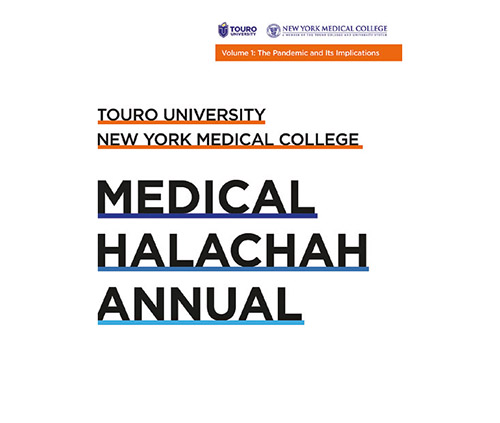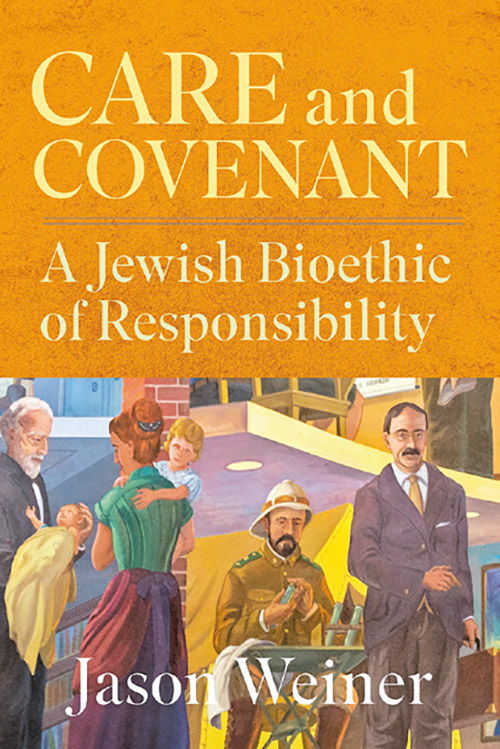
Reviewing: “Medical Halachah Annual: Volume 1: The Pandemic and Its Implications” editor Dr. Edward Lebovics, MD (Touro University and New York Medical College) Mosaica Press. 2023. English. Hardcover. 165 pages. ISBN-13: 978-1957579658.
The COVID-19 pandemic is approaching the three-and-a-half-year mark. It changed our lives significantly, and its long-term effects are still being worked out. It upended Jewish religious life to a degree not seen in many generations. The medical field was also considerably affected to a degree not seen in many years. And for many healthcare workers, it was their finest hour.
From a halachic perspective, the pandemic created countless questions. These questions often involved life and death matters. Adding to the turmoil, these halachic questions had to be answered in real-time and quickly.

In the inaugural volume of the Touro University New York Medical College journal Medical Halachah Annual, Volume 1: The Pandemic and Its Implications, editor Dr. Edward Lebovics, MD, has 14 essays from a variety of medical and rabbinic figures on topics related to the pandemic.
The book opens with a somewhat sobering observation by Lebovics, where he had to intervene when a world-renowned posek made a halachic decision that contradicted current clinical data. This reiterates the importance for poskim to ensure effective communication with physicians who are experts in their field.
Medical decisions, in general, are a matter of dealing with risk. If something has zero risk, it likely has no benefit either. With that, the volume opens with a fascinating essay on Risk Assessment in Halachah by Rabbi Meyer Twersky. A critical point Twersky makes is that proper halachic assessments require nuanced statistical analysis.
Part of the challenge in making such an assessment, Rabbi Dr. Avraham Steinberg, MD, makes in his essay, is that some of the Talmudic halachic terms are difficult to relate to in specific situations in current times. This is partly due to the conceptual difficulty in understanding the differences between the various halachic terms used and the difficulty in relating the definitions described in the Talmud and medieval authorities to modern times.
Surprisingly, one of the most important references on halacha and risk that Twersky (and everyone in this volume) didn’t reference is the Ph.D. dissertation Probability and Statistical Inference in Ancient and Medieval Jewish Literature of HaRav Nahum Rabinovitch. Rabinovitch showed that the rabbis of the Talmud had a highly sophisticated approach to probability and statistics. As Steinberg noted, the challenge is using Babylonian terminology and making sense of it in current times.
Rabinovitch’s genius was that he was able to take these terms and concepts and show how they could be applied to current times. While modern game theory originated with Jewish Hungarian mathematician John von Neumann in the 20th century, Rabinovitch showed how the rabbis of the Talmud used various aspects of game theory.
During the pandemic, there was no shortage of sweeping halachic statements, often made by those with dubious qualifications. In his brilliant and insightful essay, Rabbi Ahron Lopiansky, the greatest overall Talmudic scholar in the United States today, writes that the Chazon Ish was wary of sweeping pikuach nefesh leniencies for potential cases, as these could totally destroy Shabbos.
Similarly, he writes that the Chofetz Chaim ruled that when 300 Jewish workers lost their jobs, they could work on Shabbos. But he did not publicize this ruling lest Shabbos be destroyed.
If there is any silver lining to the pandemic, it is that it highlighted the valiant effort of many in the Jewish world. One of those at the forefront was Rabbi Dr. Aaron Glatt, MD, who has a chapter on Bikkur Cholim and the Contagious Patient.
This is a fascinating journal that details the halachic and medical issues that we face and are facing. Some of the brightest minds today have put their brilliance into the written world here. There are no simple answers to the myriad quandaries the pandemic wrought upon us. The authors here detail those complexities, and their insights give the reader a meaningful understanding of how to deal with these issues.
Reviewing: “Care and Covenant: A Jewish Bioethic of Responsibility” by Jason Weiner. Georgetown University Press; Reprint edition. 2023. English. Paperback. 130 pages. ISBN-13: 978-1647123185.
Rabbi Jason Weiner is the senior rabbi and director of the Spiritual Care Department at Cedars-Sinai Medical Center in Los Angeles. As a board-certified chaplain, Weiner has a difficult job. While most patients leave the hospital, there are those who don’t. And dealing with those end-of-life and other bioethical issues brings with it a large set of complex problems.
In Care and Covenant: A Jewish Bioethic of Responsibility, Weiner has written a fascinating monograph dealing with some of these contemporary issues and questions.
The book is about applying classical Jewish values to bioethical dilemmas. It also seeks to develop an approach primarily informed by personal and communal obligations and social responsibilities.
With this book and his article on Adult ECMO and Mechanical Circulatory Support in the Touro University Medical Halachah Annual journal, in addition to his book Jewish Guide to Practical Medical Decision-Making, Weiner has become one of the most perceptive writers on the topic.
While the book is intended for healthcare practitioners, bioethicists and public health officials, the topic is, in fact, relevant to everyone, as ethics, in general, and bioethics, specifically, are relevant to all.
Two of the many bioethical cases the book details is when King Saul ordered the commanders of his army to execute all of the innocent priests in the city of Nov, as detailed in Samuel 1 22:17. They refused to carry out the king’s orders as there was no duty to obey him, as his order was inherently wrong.
Before that, the first recorded instance of bioethical civil disobedience was the midwives Shifra and Puah. Their fear of God motivated them to refuse to obey Pharaoh’s immoral order to kill all Jewish baby boys.
Weiner has written a fascinating book dealing with some of the most vexing and complex medical issues we face. Its only shortcoming is that at just over 100 pages, this book needs to be significantly longer given the breadth of topics and Weiner’s writing talents.










